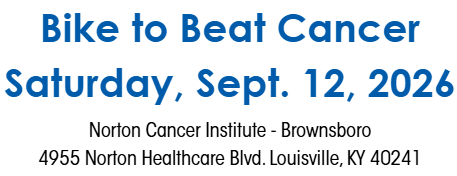Bike to Beat Cancer 2026 supporting Norton Cancer Institute



🚴♂️ Supported Rides: 5, 15, 35, or 65 miles
🚴♀️ Spin Ride
🙌 Volunteer and cheer on the riders!
Enjoy the Celebration of Courage with food, live music, bounce houses, and fun activities for all ages.
The Bike to Beat Cancer started as a way to bring our community together to help get us one step closer to ending cancer. Just about everyone can say they have been touched by cancer, and we wanted to offer a way to make a difference for our friends, loved ones, neighbors and community members who are fighting for their lives.
Whether this will be your first time riding or you’ve experienced the event before, we are excited to have you join us for this one-day cycling event! Not a cyclist? Join us in our one-mile fun walk or sign up to volunteer!
When you sign up to participate in the Bike to Beat Cancer, the funds you raise will help with prevention and early detection initiatives, advanced treatments, survivorship programs and clinical research at Norton Cancer Institute.
The 2025 Bike to Beat Cancer was a powerful reminder of what we can accomplish when we ride as one. From sunrise starts to finish-line celebrations, every pedal stroke fueled hope for patients and families across Kentucky. Thanks to your energy, heart, and fundraising efforts, we’re making real progress in the fight against cancer—supporting lifesaving research, innovative treatments, and compassionate care for all ages. Relive the unforgettable moments, the community spirit, and the impact you made. Because every mile matters. Every rider matters. And together, we’re unstoppable.
Every dollar raised through Bike to Beat Cancer is helping Norton Healthcare bring world-class care closer to home.
At Norton Cancer Institute, defeating cancer is more than a mission — it’s a promise. As the region’s leader in cancer care and research, we provide patients across Kentucky, Southern Indiana, and beyond with innovative treatments, compassionate support, and access to cutting-edge clinical trials.
In this video, discover how our team of subspecialized oncologists, researchers, and caregivers deliver personalized care through:
🧬 Advanced clinical trials and genomic testing
🧠 Multidisciplinary programs for breast, brain, lung, GI, and more
💊 On-site specialty pharmacy and same-day appointments
🎨 Holistic services like art therapy, rehab, and genetic counseling
🏥 Convenient locations across Louisville and the region
We're not just treating cancer — we’re working to end it.